1998 GMC SIERRA tow
[x] Cancel search: towPage 135 of 452
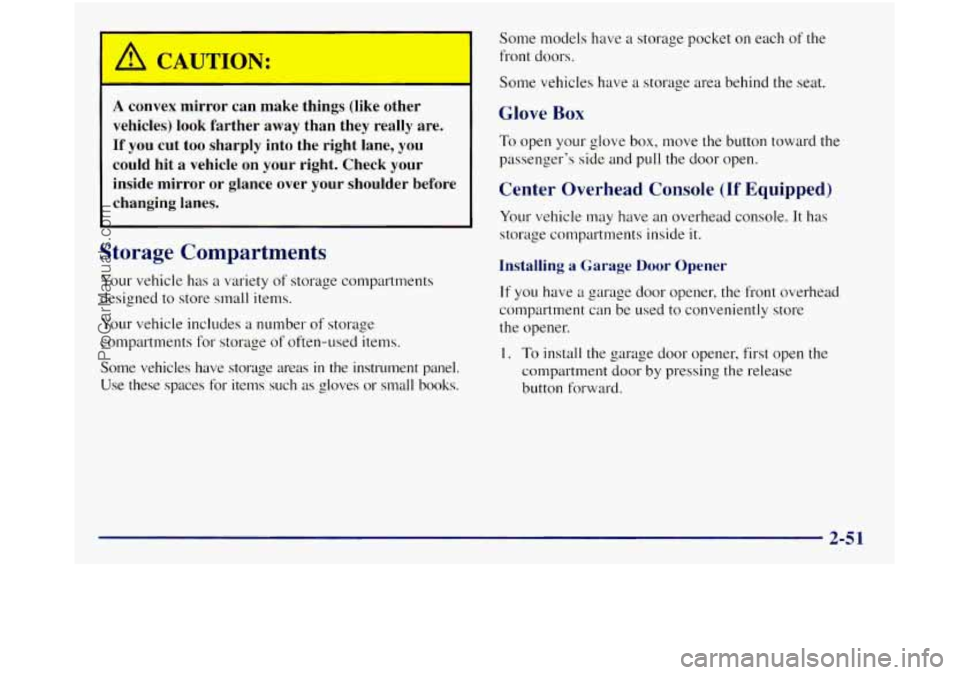
A convex mirror can make things (like other
vehicles) look farther away than they really are.
If you cut too sharply into the right lane, you
could hit a vehicle
on your right. Check your
inside mirror or glance over your shoulder before
changing lanes.
Storage Compartments
Your vehicle has a variety of storage compartments
designed to store small items.
Your vehicle includes a number of storage
compartments for storage
of often-used items.
Some vehicles have storage areas
in the instrument panel.
Use these spaces for items such as gloves or small books. Some
models have
a storage pocket on each of the
front doors.
Some vehicles have a storage area behind the seat.
Glove Box
To open your glove box, move the button toward the
passenger’s side and pull the door open.
Center Overhead Console (If Equipped)
Your vehicle may have an overhead console. It has
storage compartments inside it.
Installing a Garage Door Opener
If you have a garage door opener, the front overhead
compartment can be used to conveniently store
the opener.
1. To install the garage door opener, first open the
compartment door by pressing the release
button forward.
2-51
ProCarManuals.com
Page 140 of 452
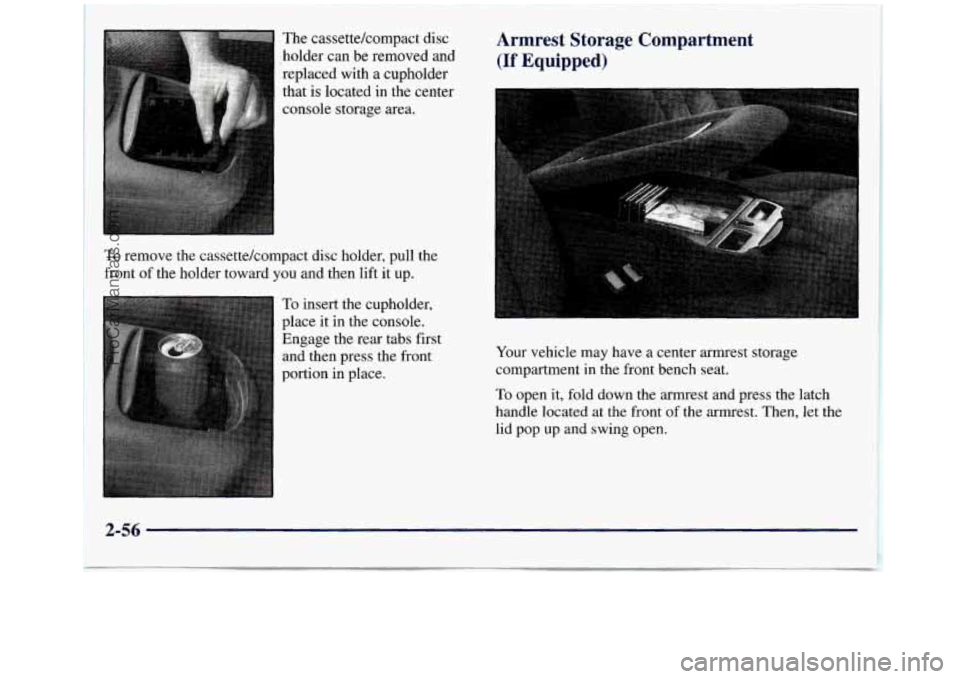
The cassettekompact disc
holder can be removed and
replaced with a cupholder
that is located in the center
console storage area.
To remove the cassettekompact disc holder, pull the
front
of the holder toward vou and then lift it up.
To insert the cupholder,
place it in the console.
Engage the rear tabs first and then press the front
portion in place.
Armrest Storage Compartment
(If Equipped)
Your vehicle may have a center armrest storage
compartment in the front bench seat.
To open it, fold down the armrest and press the latch
handle located at the front of the armrest. Then, let the
lid pop up and swing open.
2-56
ProCarManuals.com
Page 142 of 452
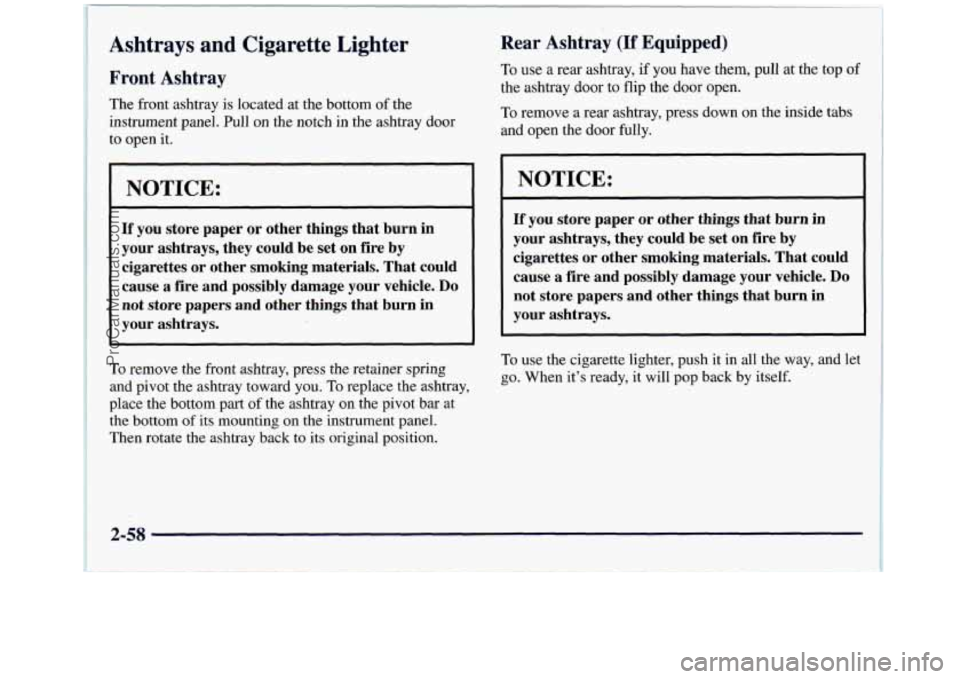
Ashtrays and Cigarette L - ;er
l Front Ashtray
The front ashtray is located at the bottom of the
instrument panel. Pull
on the notch in the ashtray door
to open it.
NOTICE:
If you store paper or other things that burn in
your ashtrays, they could be set on fire by
cigarettes or other smoking materials. That could
cause
a fire and possibly damage your vehicle. Do
not store papers and other things that burn in
your ashtrays.
To remove the front ashtray, press the retainer spring
and pivot the ashtray toward you.
To replace the ashtray,
place the bottom part
of the ashtray on the pivot bar at
the bottom
of its mounting on the instrument panel.
Then rotate the ashtray
back to its original position.
Rear Ashtray (If Equipped)
To use a rear ashtray, if you have them, pull at the top of
the ashtray door to flip the door open.
To remove a rear ashtray, press down on the inside tabs
and open the door fully.
NOTICE:
If you store paper or other things that burn in
your ashtrays, they could be set on fire
by
cigarettes or other smoking materials. That could
cause
a fire and possibly damage your vehicle. Do
not store papers and other things that burn in
your ashtrays.
To use the cigarette lighter, push it in all the way, and let
go. When it's ready, it will pop back by itself.
2-58 !
I
ProCarManuals.com
Page 152 of 452
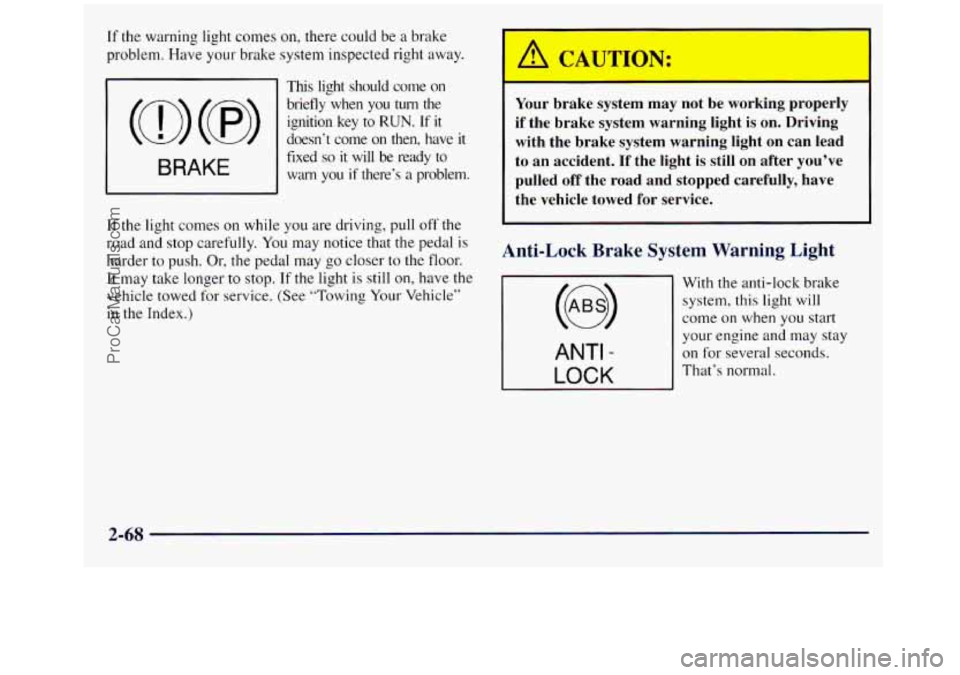
If the warning light comes on, there co11ld be a brake
problem. Have your brake system inspected right away.
This light should come on
(a) (@)
briefly when you turn the
ignition key
to RUN. If it
doesn‘t come on then, have
it
fixed so it will be ready to
warn you if there’s a problem. BRAKE
If the light comes on while you are driving, pull off the
road and
stop carefully. You may notice that the pedal is
harder
to push. Or, the pedal may go closer to the floor.
It may take longer to stop.
If the light is still on, have the
vehicle towed
for service. (See “Towing Your Vehicle”
in the Index.)
Your brake system may not be working properly
if the brake system warning light is
on. Driving
with the brake system warning light on can lead
to an accident.
If the light is still on after you’ve
pulled off the road and stopped carefully, have
the vehicle towed for service.
Anti-Lock Brake System Warning Light
With the anti-lock brake
system,
this light will
come on when you start
ANTI -
LOCK
your engine and may stay
on for several seconds.
That’s normal.
2-68
ProCarManuals.com
Page 154 of 452
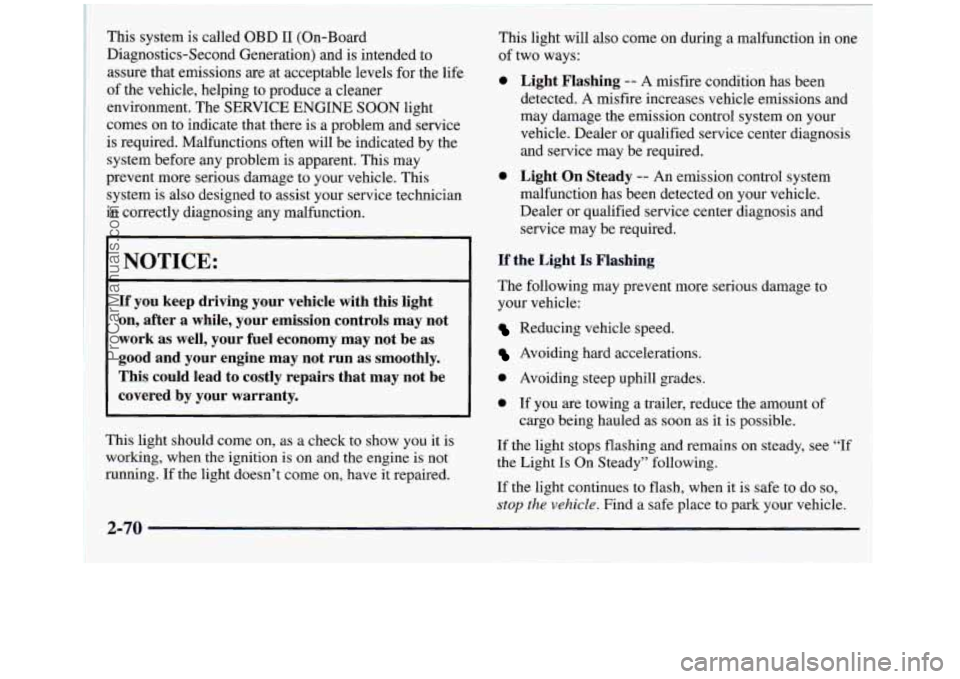
This system is called OBD I1 (On-Board
Diagnostics-Second Generation) and is intended to
assure that emissions are at acceptable levels for the life
of the vehicle, helping to produce a cleaner
environment. The
SERVICE ENGINE SOON light
comes on to indicate that there is a problem and service
is required. Malfunctions often will be indicated by the
system before any problem is apparent. This may
prevent more serious damage to your vehicle. This
system is also designed to assist your service technician
in correctly diagnosing any malfunction.
~OTICE:
If you keep driving your vehicle with this light
on, after a while, your emission controls may not
work as well, your fuel economy may not be as
good and your engine may not run as smoothly.
This could lead to costly repairs that may not be
covered by your warranty.
This light should come on, as a check to show you it is
working, when the ignition is on and the engine is not
running. If the light doesn’t come on, have it repaired.
2-70
This light will also come on during a malfunction in one
of two ways:
0 Light Flashing -- A misfire condition has been
detected. A misfire increases vehicle emissions and
may damage the emission control system on your
vehicle. Dealer or qualified service center diagnosis
and service may be required.
0 Light On Steady -- An emission control system
malfunction has been detected on your vehicle.
Dealer or qualified service center diagnosis and
service may be required.
If the Light Is Flashing
The following may prevent’more serious aamage to
your vehicle:
Reducing vehicle speed.
Avoiding hard accelerations.
0 Avoiding steep uphill grades.
0 If you are towing a trailer, reduce the amount of
cargo being hauled as soon as it is possible.
If the light stops flashing
and remains on steady, see “If
the Light Is On Steady” following.
If the light continues
to flash, when it is safe to do so,
stop the vehicle. Find a safe place to park your vehicle.
ProCarManuals.com
Page 162 of 452
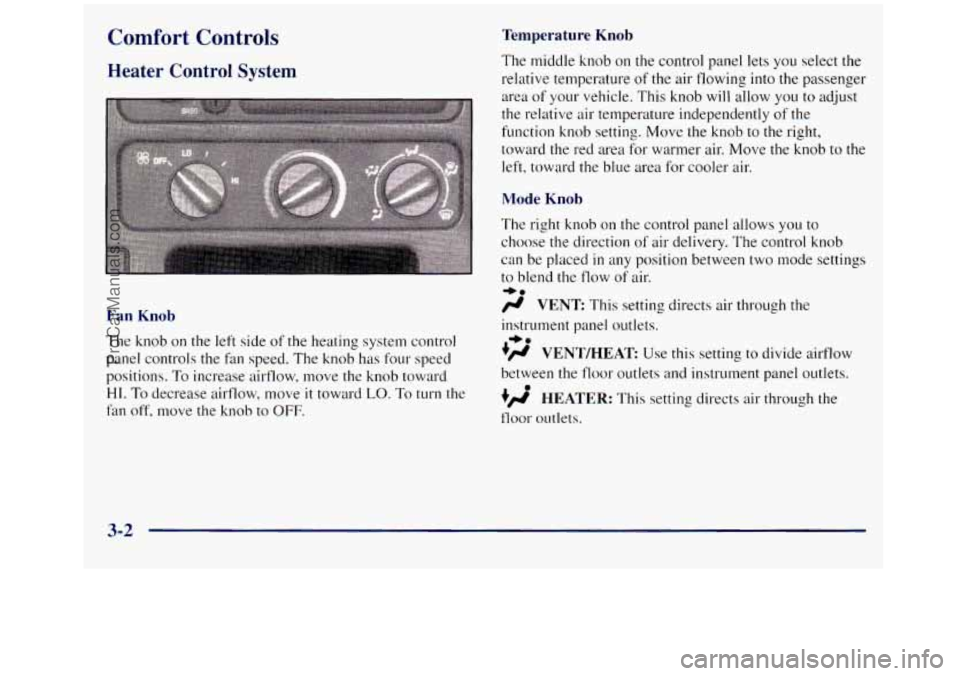
Comfort Controls
Heater Control System
Fan Knob
The knob on the left side of the heating system control
panel controls the fan speed. The knob has four speed
positions.
To increase airflow, move the knob toward
HI. To decrease airflow, move it toward LO. To turn the
fan off, move the knob to OFF.
Temperature Knob
The middle knob on the control panel lets you select the
relative temperature
of the air flowing into the passenger
area of your vehicle. This knob will allow you to adjust
the relative air temperature independently
of the
function knob setting. Move the knob to the right,
toward the red area for warmer air. Move the knob
to the
left, toward the blue area for cooler air.
Mode Knob
The right knob on the control panel allows you to
choose the direction
of air delivery. The control knob
can be placed
in any position between two mode settings
to blend the flow of air.
/r VENT This setting directs air through the
-bo
instrument panel outlets.
.)rr VENT/HEAT Use this setting to divide ailflow
between the floor outlets and instrument panel outlets.
+/r HEATER: This setting directs air through the
floor outlets.
+e
0
3-2
ProCarManuals.com
Page 163 of 452
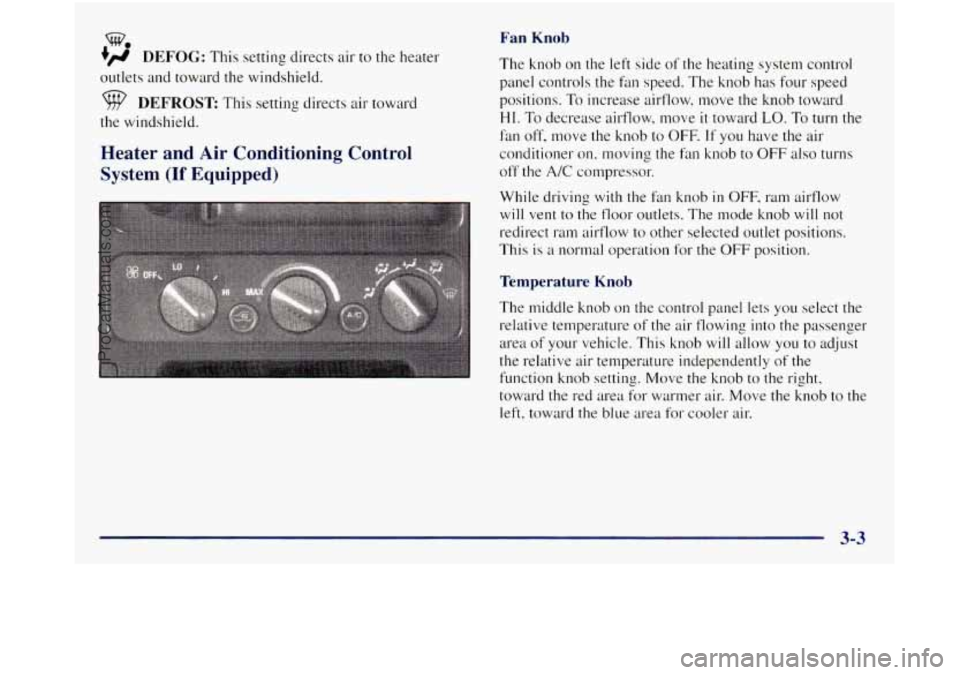
w.
+’ DEFOG: This setting directs air to the heater
outlets and toward the windshield.
DEFROST: This setting directs air toward
the windshield.
Heater and Air Conditioning Control
System
(If Equipped)
Fan Knob
The knob on the left side of the heating system control
panel controls the fan speed. The knob has four speed
positions. To increase airflow. move the knob toward
HI. To decrease airflow, move it toward LO. To turn the
fan
off, move the knob to OFF. If you have the air
conditioner
on. moving the fan knob to OFF also turns
off the
A/C compressor.
While driving
with the fan knob in OFF, ram airtlow
will vent to the
floor outlets. The mode knob will not
redirect ram airflow to other selected outlet positions.
This is
a normal operation for the OFF position.
Temperature Knob
The middle knob on the control panel lets you select the
relative temperature of the air flowing into the passenger
area of your vehicle. This knob will allow you to adjust
the relative air temperature independently
of the
function knob setting. Move the
knob to the right,
toward the red area for warmer
air. Move the knob to the
left, toward the blue area for cooler air.
3-3
ProCarManuals.com
Page 164 of 452
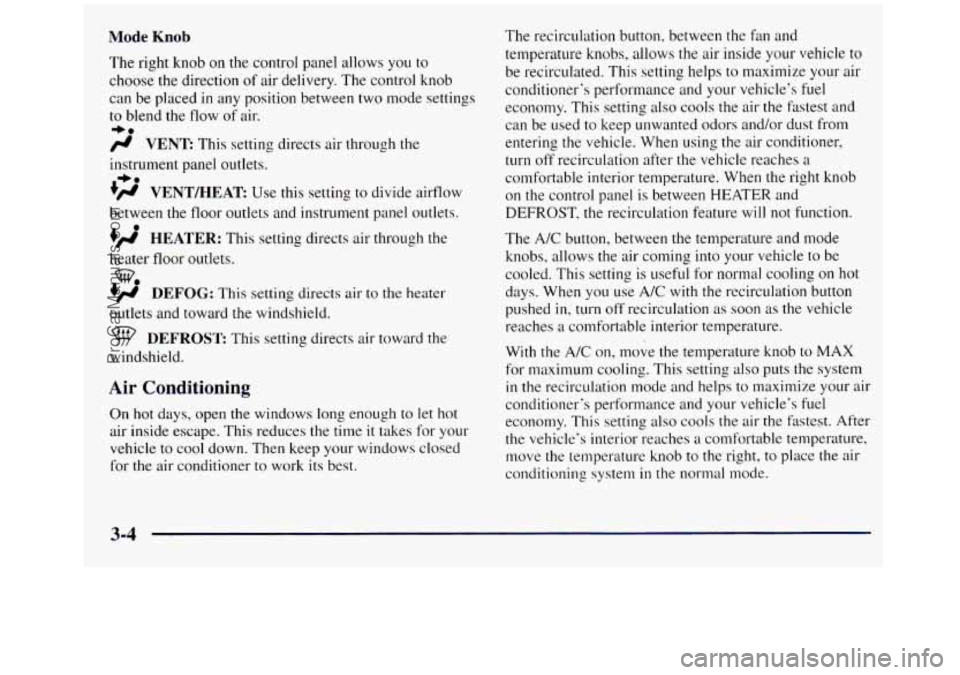
Mode Knob
The right knob on the control panel allows you to
choose the direction
of air delivery. The control knob
can be placed in any position between two mode settings
to blend the flow of air.
+e
/$ VENT This setting directs air through the
instrument panel outlets.
+’ VENT/HEAT Use this setting to divide airflow
between the floor outlets and instrument panel outlets.
+’ HEATER: This setting directs air through the
+e
0
heater floor outlets.
+’ DEFOG: This setting directs air to the heater
we
outlets and toward the windshield.
DEFROST This setting directs air toward the
windshield.
Air Conditioning
On hot days, open the windows long enough to let hot
air inside escape. This reduces the titne
it takes for your
vehicle to cool down. Then keep your windows closed
for the air conditioner to work its best. The recirculation button, between the
fan and
temperature
knobs, allows the air inside your vehicle to
be recirculated. This setting helps to maximize your air
conditioner’s performance and your vehicle’s fuel
economy. This setting also cools the air the fatest and
can be used
to keep unwanted odors and/or dust from
entering the vehicle. When using the air conditioner,
turn off recirculation after the vehicle reaches
a
comfortable interior temperature. When the right knob
on the control panel is between HEATER and
DEFROST, the recirculation feature will not function.
The A/C button, between the temperature and mode
knobs, allows the air coming into your vehicle to be
cooled. This setting is useful for normal cooling on hot
days. When you use
A/C with the recirculation button
pushed
in, turn off recirculation as soon as the vehicle
reaches
a comfortable interior temperature.
With the A/C
on, move the temperature knob to MAX
for maximum cooling. This setting also puts the system
in the recirculation mode and helps to maximize your air
conditioner‘s performance and your vehicle’s fuel
economy. This setting also cools the air the Fdstest. After
the vehicle‘s interior reaches
a comfortable temperature,
move the temperature knob to the right, to place the air
conditioning system
in the normal mode.
3-4
ProCarManuals.com